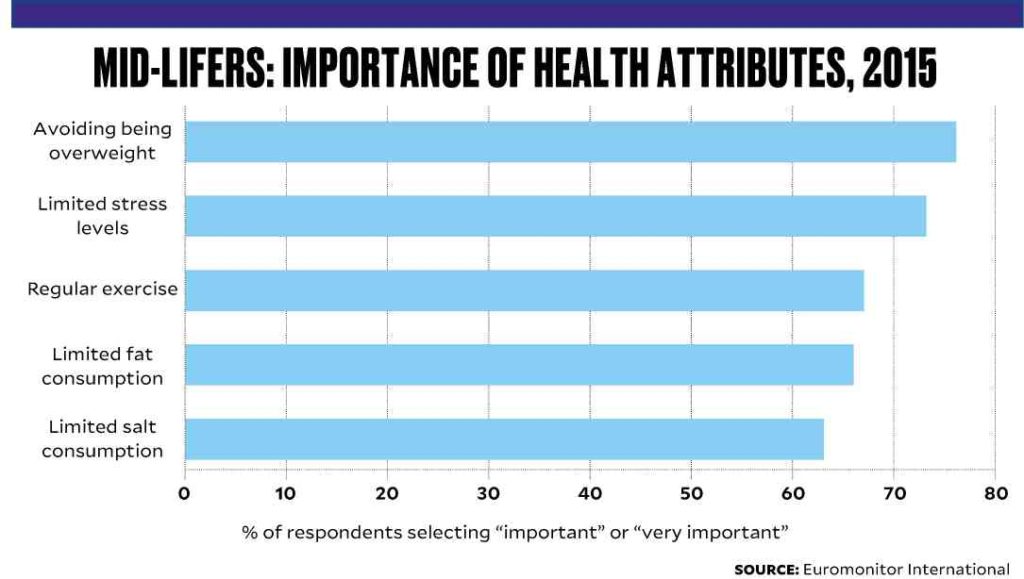Don’t forget the mid-lifers.
It’s a reminder issued to brand marketers by global market research firm Euromonitor International, through its recent report “Global Mid-Lifers at a Crossroads: Lifestyles and Market Impact,” which examines lifestyle and spending habits of what it identifies as a largely ignored segment of the population: those aged 45-59 years old.
“Despite often being ignored by marketers, who tend to focus their attention on the younger millennials and the older later-lifers, mid-lifers form a vast and relatively affluent cohort, representing 16 percent of the global population… a share that continues to rise as the world ages,” the report reads. “China alone accounts for 26 percent of the world’s 45- to 59-year-olds, while growth since 2010 has been fastest in youthful countries such as Saudi Arabia (41 percent).”
The report describes mid-lifers as an age group that’s “far from homogenous in terms of lifestyle, life stage and household structure.”
There are the empty nesters who are now more busy with their careers; those lucky enough to be enjoying early retirement, or have received their inheritance and are free to spend on luxuries such as travel; and those who decided to postpone having kids to pursue first their careers, and are therefore still taking care of young children as well as aging parents.
Despite their different situations, mid-lifers, the study finds, are overall in good financial shape, with the highest spending power among all age groups.
“Euromonitor International data confirms that, at a global level, mid-lifers earn significantly more than average, with income tending to rise with age. Against an average gross income of $12,866 in 2015, those aged 45-49 received $15,245, those aged 50-54 received $16,398, and those aged 55-59 received $16,916,” the report reads.
However, the report also notes that incomes for mid-lifers have also been rising at a lower rate than the global average of 8 percent across all age groups from 2010-2015.
“Those aged 45–49 saw their incomes rise by just 1 percent,” the report states. “Those aged 50–54 experienced a slightly higher increase of 4 percent… [while] mid-lifers in the upper age bracket (55–59) enjoyed the strongest increase in average income. Many people in this age group have managerial positions and are at their peak earning power.”
Mid-lifers’ incomes also vary among countries, says Euromonitor.
In developed markets such as Switzerland, the US, Denmark, Norway, the UK and Australia, it is the early mid-lifers (45-49 years old) who earn the most, with some enjoying an average gross income of up to over $100,000.
In contrast, early mid-lifers in emerging markets such as Russia, Colombia, China, Indonesia and India earned an average gross income of only $2,544.
One thing is common among all mid-lifers, however: Health is their No. 1 priority.
“Euromonitor International’s Global Consumer Trends Survey of 2015 found that for global mid-lifers, good health is the top contributor to personal happiness, with 86 percent of respondents placing it in the top three, followed by supportive family relationships (78 percent). Mid-lifers were more likely than other age groups to rank these two factors in the top three,” the report states.
The majority, in particular, are concerned about avoiding being overweight, and are thus becoming more involved in sports, such as cycling and running—which in turn has increased demand for bicycles, sports clothing, fitness trackers, and other related products.
“Gone are the days when mid-life was associated with golfing and sports cars. The last few years have seen the rise of the MAMIL (middle aged men in Lycra), as mid-lifers are focusing on improving their health and appearance through diet, exercise and lifestyle,” reads the report.
Family is also one of mid-lifers’ top priorities when it comes to their personal happiness.
The same survey found that mid-lifers cited their children as a factor that becomes more important to them as they age (56 percent). This contrasted their attitude toward friends and social status; only 37 percent and 17 percent, respectively, included these factors among their top three.
Ultimately, mid-lifers are described by Euromonitor as a “lucrative market” which will only continue to grow in the coming years.
According to the report, their population numbers are expected to increase by 10 percent globally until 2020, with the growth coming largely from the Middle East and Africa (17 percent), and Asia Pacific and Latin America (both at 11 percent).
It’s an age group with relatively high incomes, but are cautious about saving for their future and are out to get the best value for their money.
“In terms of marketing, mid-lifers do not want to be ignored by businesses, but nor do they want to be singled out, stereotyped or treated in a patronizing manner. Marketers need to be inclusive, targeting their products and services at all ages,” the report states. “Mid-lifers should be targeted in terms of life stage as much as age. For those harried parents squeezed between bringing up children and looking after aging parents, convenience and price will be key factors in purchasing decisions. In some cases, mid-lifers are buying for both younger and older relatives, thus attracting this group should be a priority for any marketer.”


